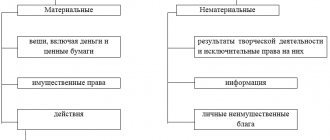General characteristics of objects of civil rights
The concept and types of objects of civil rights are strongly interrelated. Over the years, the theory of civil law has identified the following features of the objects of civil rights:
- they are objects (phenomena) of the material or immaterial world. If the former include things that have a substrate, then the latter include objects such as exclusive rights, honor and dignity, as well as business reputation. They are owned by a person (personal non-property rights). These include the process by which new items are created, for example, during a contract or as a result of other activities;
- they serve as a reason for the emergence and termination, as well as changes in legal relations between entities provided for in the Civil Code of the Russian Federation;
- negotiability of objects of civil rights. This characteristic presupposes the possibility of their transition as a result of an action carried out by any entity provided for by the Civil Code of the Russian Federation. The negotiability of objects of civil rights may be limited by law. They may be owned by a specific entity, or transactions in relation to them will require special permission. Land plots are included in a separate category. There are other objects of civil rights, the negotiability of which is impossible due to their nature. Intangible benefits as objects of civil rights (honor, dignity and business reputation) cannot be alienated due to their nature. However, they are so because their protection is guaranteed.
Taking these points into account, we can give the following definition. Objects of civil rights should be understood as objects and phenomena of a material and intangible nature, or the process of their creation, which serve as the basis for legal relations, usually having negotiability.
There is also an opinion that the objects of civil rights are the goals or results towards which certain legal relations into which a person enters are oriented.
Objects of civil legal relations and their civil legal regime
The behavior of participants in legal relations cannot be considered in isolation from the objects in relation to which it is carried out, because such behavior is never pointless and aimless. The meaning of the category of objects of civil legal relations (objects of civil rights) is to establish for them a certain civil legal regime, i.e. the possibility or impossibility of performing certain actions (transactions) with them, entailing a certain legal (civil) result. It is clear that such a regime is actually established not for various goods, but for people who perform various legally significant actions in relation to these goods. In other words, it determines the behavior of participants in legal relations regarding the corresponding material and intangible benefits. It is the legal regime (and not their physical properties) that distinguishes various objects of civil circulation from each other, and it is this side of them that is important for civil law.
This concept originates in the works of the German scientist of the 19th century. Birling, in connection with which it is called the “Birling concept” of the object of civil rights (for more details, see, for example: Agarkov M.M. Obligation under Soviet civil law // Selected works on civil law: In 2 vols. T. IM, 2002 pp. 194-195).
The different nature of the named objects of civil legal relations also implies differences in the content of the legal relations themselves that arise in connection with them. Thus, things are objects of real rights, while actions, as well as property rights and obligations, can be objects of obligatory or corporate rights, but not real relations. Therefore, it is impossible to become an “owner of the right”, i.e. obtain a real "right to right".
Things, of course, are goods in the economic sense, but a much wider range of objects have the properties of goods. It, in particular, covers the intangible results of creative activity (scientific and technical ideas and solutions embodied in the form of drawings, technical devices, magnetic recordings or disks; artistic images expressed in manuscripts, paintings and other works of art, etc.) , as well as means of individualizing goods and their manufacturers (brand names, trademarks, etc.). Such objects cannot be physically possessed as a thing, because possessing a material carrier of an idea (for example, a drawing, device or manuscript) does not at all make it the acquirer “ owner", i.e. the exclusive owner of the corresponding idea, because in principle nothing prevents its creator (author) from reproducing the corresponding material carrier, as long as the idea or symbol is preserved in his consciousness. Therefore, the results of creative activity, which have the properties of a product, become objects of intellectual rather than property rights, i.e. have a special civil legal regime.
In other words, various types of civil legal relations correspond to certain groups of objects of civil rights. From this point of view, one should distinguish between objects
- real,
- obligatory,
- corporate and
- intellectual rights, as well as
- objects of personal non-property rights.
Types of objects of civil rights
The system of objects of civil rights is ramified. They are described in chapters 6 – 8 of the Civil Code of the Russian Federation.
The criterion can be the content of substance in objects. Depending on this, material objects and intangible goods are distinguished.
Classification depending on the subject assumes the presence of state property and privately owned things.
The general classification involves the following categories:
- things, as well as other property equivalent to them;
- the result of work or the process of providing services;
- intellectual property representing exclusive rights that are provided with a special regime of protection;
- intangible benefits, including personal non-property rights. They also include honor, business reputation and dignity.
The concept of civil legal relations
Definition 1
Civil legal relations are recognized as social relations arising between subjects of civil law, which are based on the will and independence of the participants in these relations, are bound by civil rights and obligations and arise on the grounds provided for by the legislation of the Russian Federation.
In other words, a civil legal relationship is understood as a legal relationship regulated by the norms of civil legislation and arising between entities that have equal legal status regarding property and intangible benefits and is expressed in the presence of certain rights and obligations among these entities.
Civil legal relations consist of the following elements:
Are you an expert in this subject area? We invite you to become the author of the Directory Working Conditions
- subjective composition of the legal relationship;
- the content of the legal relationship – the rights and obligations of the subjects;
- the object of the legal relationship (what the legal relationship arises about).
Civil legal relations arise if the following grounds exist:
- contracts and other transactions that do not contradict the law;
- acts of state bodies and local governments;
- court decisions;
- as a result of the acquisition of property;
- as a result of the creation of works of science, literature and art;
- as a result of causing harm;
- in the course of unjust enrichment;
- as a result of other actions of citizens and legal entities.
Things as objects of civil rights
Things are the broadest category of objects of civil rights. Art. 129 provides for the classification of things based on their negotiability. According to this criterion, things that are fully available for circulation (for example, money), those that are limited in circulation (for example, land plots of certain categories), and things that are withdrawn from circulation are distinguished. Classifying them into one category or another has high legal significance.
There are divisible and indivisible things. If in the first case we are talking about the possibility of dividing an object with the formation of independent things, then in the second situation this is impossible due to the harm caused to such an object of property rights.
Complex things are identified (Article 134 of the Civil Code of the Russian Federation), the use of which is possible if all the constituent elements are present. The law also establishes the relationship between the main thing and the accessory. The latter by default follows the fate of the first (for example, the ignition key of a car), unless other requirements are taken into account in the agreement.
Separate regulation is provided for fruits and income that are generated as a result of the use of things. They are received by the entity using the property, unless the content of the agreement suggests otherwise.
The most well-known classification is the division of things into movable and immovable. The former are amenable to free movement in space, unlike the latter (an attempt to perform these actions will lead to damage).
Do you need help with civil matters?
We will analyze your prospects for free!
+7
Concept and classification of things
1. The main component of property are things - it is through things that the bulk of the subjects’ needs are satisfied.
A thing is an object of the material world that can be owned by a person and serves to satisfy his needs.
The thing is material. It exists steadily regardless of the subject.
A thing as a physical body has mass and spatial limits.
Therefore, things are easy and convenient to appropriate, which has made things historically the first class of objects of civil legal relations.
The classification of things existing in civil law is based primarily on the distinction between the actually existing typical properties of a particular set of things. Classification establishes for each group of things a legal regime corresponding to its natural or social properties.
2. Movable and immovable things. One of the most important criteria for classifying things is their ability to move. On this basis, all things are divided into movable and immovable. Any thing firmly connected with the land is considered immovable. The connection with the earth is manifested in the fact that this thing cannot be moved without disproportionate damage to its purpose. The Civil Code provides examples of immovable things - land plots, subsoil plots, buildings, structures, unfinished construction objects. All these objects belong to the category of things “immovable by nature.” At the same time
The Code also allows for the existence of “real estate by law.” The Civil Code directly calls aircraft, sea vessels and inland navigation vessels subject to state registration real estate. In addition, immovable things include premises and parking spaces inside buildings, if the boundaries of such premises and places are described in the prescribed manner (paragraph 3, paragraph 1, article 130 of the Civil Code).
The concept of movable things is defined in law according to the residual principle - any thing that is not related to real estate is movable.
The legal significance of the distinction between movable and real estate is the establishment of special rules for the circulation of real estate. As a general rule, real rights to real estate and the movement of these rights are subject to state registration. On the contrary, special registration of rights to movable things is usually not required. Most real estate transactions require adherence to the classical written form in the form of a single document under penalty of invalidation of the transaction, while transactions with movable things are subject to general rules on the form of transactions. Real estate can be acquired by prescription no earlier than after 15 years, although five years is enough for movable property.
3. Divisible and indivisible things. In the physical sense, there are no indivisible things; everything can be divided if desired. However, the Civil Code still talks about indivisible things. Indivisible is such a thing, the division of which in kind is impossible without destroying, damaging the thing or changing its purpose and which acts in circulation as a single object of real rights (even if it has component parts).
A CD sawed in half cannot be played and is just in time to be thrown away (destruction). A car that has been disassembled for spare parts can, in principle, be put back together, but when disassembled it cannot be used to move in space. If we take things such as seeds, food or fuel, then they can be divided almost endlessly without compromising their essence and purpose.
As a general rule, an indivisible thing can become the subject of recovery only in its entirety. In property relations, the indivisibility of a thing leads to the emergence of relations of common ownership when such a thing comes into the possession of several persons. Co-owners cannot terminate the right of common ownership by physically dividing the property. Instead, payment of monetary compensation is used.
The indivisibility of a thing as the subject of an obligation gives rise to the solidarity of the obligation, whereas, as a general rule, when there is a plurality of persons, the obligation is shared. The indivisibility of a thing as an object of inheritance gives the heir who used the thing before the opening of the inheritance a priority right to receive it.
4. Simple and complex things. Civil law primarily relies on the concept of a single corporeal material thing. He calls a complex thing a collection of different things that are connected in a way that presupposes their use for a general purpose (herd, library, service).
The legal significance of distinguishing the category of complex things is to facilitate circulation. The effect of a transaction concluded regarding a complex thing extends to all its components. However, the parties in this matter are given freedom of choice, since this norm is formulated as dispositive.
5. The main thing and accessory. The classification criterion here is the independence of the appearance of the thing in circulation. The main thing is used, as a rule, independently and, in principle, can do without accessories. The accessory usually serves the main thing and is not used independently. Examples include a musical instrument and its case, a device with a remote control (assuming the device can be operated without a remote control), a car, and a jack.
Belonging follows the fate of the main thing. If someone wants to put a thing into circulation without ownership, an appropriate reservation must be made about this.
6. The main thing (capital) in relation to fruits, products and income. Things in the process of their use can bring additional income to their owner. Traditionally, there are three types of such income: fruits, products and income.
Fruits are usually called products of organic development of things that do not require active human participation for their appearance. Products are considered the result of the productive use of a thing. Products do not arise without human effort.
Income is income (most often monetary) from the participation of a thing in civil circulation.
In principle, a single legal regime is established for all three types of proceeds from a thing. According to the Civil Code, any proceeds from the use of property belong to the owner of the main thing. Otherwise may be established by law (for example, Article 606 of the Civil Code) or by contract, and may also arise from the essence of the obligation.
7. Animate and inanimate things. The bulk of things involved in civil circulation are material, inanimate objects. When civil legal relations arise regarding living beings, special rules are applied to them first, and only then, if there are none, general rules about property are applied.
All animals are subject to a cruelty-free policy. Wild animals can become the property of a private person only after they have been legally removed from their habitat; before that, they are the property of the state. When determining the legal fate of pets, their attachment to humans may be taken into account. If the fact of cruelty to pets is established, any person can legally demand their forced ransom.
8. Consumable and non-consumable things. The essence of the difference between these categories is the answer to the question: does a thing retain its properties after a single use? If a thing disappears completely (food, fuel) or is transformed into another thing (seeds, building materials), it is consumed. If a thing gradually loses its properties during use (wears out), it is considered non-consumable (clothing, equipment).
Some civil contracts can be concluded in relation only to non-consumable things (rent). Other contracts may have as their subject matter both categories of things under consideration (purchase and sale).
9. Individually defined and generic things. The degree of individualization of things in civil circulation can be different. In some cases, it is quite enough to indicate the type and quantity of things transferred under the contract (a thousand rubles borrowed). In other cases, the law insists that the thing can be distinguished from similar things (cadastral number of the alienated property). Some things are simply unique. In most situations, the same thing, depending on the circumstances of the transaction, can be defined by its participants as both generic and individual. For example, you can buy either a certain amount of grain of a known quality (a generic item), or a given amount of it, stored in such and such a place (an individual item); one green car (generic item) or a car with this identification number (individual item).
Individually defined things are legally irreplaceable. Accidental destruction of such things frees the obligated person from the need to transfer them to the counterparty under the contract. In relation to ancestral things, on the contrary, the rule “the gens does not perish” applies. The debtor remains obligated to provide a certain number of things, because, despite the death of this batch, he still has the opportunity to find other things of the same kind and quality.
If the thing is not lost, but simply not transferred by the debtor, then only the creditor who was not too lazy to individualize the thing can demand the fulfillment of this obligation in kind. With generic items in a similar situation, you can only count on monetary compensation for damage.
10. Existing and future things. As a general rule, the law begins to react to the presence of a thing only after its appearance.
But the rights and obligations associated with a thing may arise before its actual appearance. Since ancient times, civil law has known the concept of future things, or res futura. A future thing can be the subject of an obligation, despite the fact that at the moment the obligation arises this thing does not yet exist. The future thing is not the object of property rights.
Real estate as an object of civil rights
This category of things is defined in Art. 130 Civil Code of the Russian Federation. This includes any objects firmly connected to the earth, gardens, forests, land, buildings, and other structures. What matters is that their movement in space will cause irreparable damage. The most striking example is buildings and large structures.
In addition to them, the law equates vehicles such as airplanes and sea vessels to real estate. This was done because, as a rule, they are large in size and need to take them into account.
Real estate as an object of civil rights is widely represented in the current law and has a number of special types.
One of them is provided for in Art. 132 of the Civil Code of the Russian Federation. It describes the enterprise as an object of civil rights. It is a complex thing, including not only buildings and land, but also inventory, raw materials and other property, exclusive rights and other intellectual property necessary for its activities. All this content represents a single property complex equated to real estate. This has legal significance when transferring ownership. An example is an airport, where both runways, large plots of land and structures, and buildings are important.
However, in the process of activity, intellectual property as an object of civil rights and its other components serve as the basis for the emergence of other legal relations and the usual regime applies in relation to them.
In 2013, the law was amended to provide for a different entity – a single real estate complex (Article 133.1). They mean a community of objects that perform common functions, including buildings and structures. An example is a power line. According to the law, the complex is one piece of real estate and an indivisible aggregate. A special regime is provided. Buildings and structures included in such a facility cannot be sold separately.
Content and form of civil legal relations
Contents of civil legal relations. In the process of civil law regulation of public relations, their participants are endowed with subjective rights and responsibilities, which subsequently predetermine the behavior of the participants within the framework of the existing legal relations between them. Like any social relationship, civil legal relations are established as a result of interaction between people. In a legal relationship, the interaction of its participants is carried out in accordance with the subjective rights belonging to them and the responsibilities assigned to them. Thus, in the legal relationship of purchase and sale, the seller transfers ownership of the sold item to the buyer on the terms and within the terms determined by the agreement between them, and the buyer pays the seller money in the amount and within the terms established by the same agreement.
Social relations included in the subject of civil law do not disappear as a result of their legal regulation, but only acquire a legal form with the help of which their content is streamlined. Therefore, the content of civil legal relations forms the interaction of their participants, carried out in accordance with their subjective rights and obligations.
Form of civil legal relationship. Subjective rights and obligations belonging to participants in civil legal relations,
form its legal form. Subjective right is understood as a legally enforceable measure of the possible behavior of an authorized person, and subjective obligation is a legally enforceable measure of the required behavior of an obligated person in a civil legal relationship. A feature of subjective civil rights and obligations is that they are either property or personal non-property in nature. Thus, the right of ownership is a property right that provides its owner with a legally enforceable opportunity to own, use and dispose of things belonging to him at his own discretion. The right to protection of honor, dignity and business reputation is a personal non-property right that provides an authorized person with a legally enforceable opportunity to demand a refutation of information discrediting his honor, dignity and business reputation.
Unity of content and form of civil legal relations. The civil property legal relationship cannot be completely attributed to either the economic basis or the legal superstructure. It represents a dialectical unity of economic content and legal form. The form of civil property legal relations (subjective rights and obligations) is in the area of the legal superstructure, and its content (interaction of participants) is in the area of the economic basis. Unlike property, both the form and content of personal non-property legal relations are outside the economic basis. Therefore, personal non-property legal relations relate entirely to superstructural phenomena.
In the civil literature there is a widespread opinion that the content of a civil legal relationship is formed by the subjective rights and obligations of its participants. This position is quite acceptable for those authors who consider civil legal relations as a special ideological relationship that exists along with a regulated social relationship. The content of such a legal relationship cannot be anything other than subjective rights and obligations. However, authors who consider a civil legal relationship as a social relationship itself, regulated by a norm of civil law, fall into contradiction, arguing that the content of such a legal relationship consists of civil rights and obligations. Subjective rights and obligations appear only as a result of legal regulation. Therefore, it turns out that public attitude before its legal regulation did not have its own
content, or it disappeared in the process of legal regulation. At the same time, it is quite acceptable to talk about subjective rights and obligations as the legal content of civil legal relations, since they contain the possibility of the interaction between participants in the legal relationship that forms its content. Therefore, in the future in this textbook, the legal content of civil legal relations will be understood as the subjective rights and obligations belonging to the participants in legal relations.
The specificity of civil legal relations is manifested not only in their form and content, but also in their subjects and objects.
Money, currency values and securities as objects of civil rights
The law separates these concepts. According to it, money is an equivalent used within a country and used for trade. They recognize the ruble. Foreign money (currency) is also recognized as such. At the same time, they are included in the category of currency values, which also includes external securities. Money is the object of property rights in both cash and non-cash form. The turnover of these objects is subject to exchange control requirements.
The state carries out detailed regulation of their circulation.
Securities as objects of civil rights have a dual nature.
Its content assumes that they serve as evidence of confirmation of both property and liability rights. Art. 143 establishes their types. Each of them has its own requirements.
Animals
Although animals are classified as objects of civil rights, the legislator points out their peculiarity. For this reason, one cannot say that animals are things. Modern research proves that they have some personality traits. Therefore, it is worth saying that animals are equated to things.
A regime for protecting not only the property rights of owners is provided. Animals are also subject to it, since cruelty to them is unacceptable. The corresponding requirements are contained in Art. 137 code. If the subject allows such actions, this will lead to the emergence of legal relations in another area. This is the only case when protection is guaranteed to an object.
Result of work or provision of services
Unlike the previous category, the result of work or the provision of services is not the object of property rights, but of obligations.
The most common example is a contract. Other regulation involves assessing the value of objects of civil rights. It is carried out by a qualified specialist.
Unlike a contract, which involves the creation of a thing that meets certain characteristics, assessing the value of objects of civil rights implies a process consisting of studying market conditions in relation to the subject. Although the specifics of the appraisal activity require the preparation of a report, its parameters are unknown when concluding a contract, so it is classified as a service.
Other objects
In addition to the above, the objects of civil rights include:
- work;
- service;
- result of work or service.
The process of labor activity or the provision of a service has an end product - a useful result. It can be separated from the actions that create it if they are called “work.” For example, sewing a dress in an atelier.
If the useful result is not separable from the actions and is consumed in dynamics (i.e. during the period of production itself), then they speak of a “service”. For example, transporting passengers or cargo. The usefulness of the effect lies in the very fact of moving people or objects from one point to another.
Obligations for work or services are expressed in contract, storage, commission, etc. It is noteworthy that neither work nor service can become the object of proprietary relations.
Information can act as a separate object of civil rights. Information support is present in any activity. Information is intangible and becomes obsolete from a moral point of view.
Only information media are subject to physical wear and tear. The content of the same information is unchanged even if reproduced in different forms. Kinds:
- gesture;
- oral communication;
- written communication;
- document.
An information resource is a carrier of certain data. Such resources can act as an object of property. The author of the know-how and unified technology has the absolute right to information.
Intellectual property should also be distinguished as a separate object. It means the result of creative activity or a means of individualization of the subject of a legal relationship or a product.
Property rights as objects of civil rights
The most common is the right of ownership, which implies the regime of ownership, use, and disposal of property. It is also characterized by a number of responsibilities.
Today this is a problem in the theory of civil law. Previously, theorists were limited to identifying real and property rights. However, at present, opponents of the classical theory propose, in addition to real rights, to include liability rights in this category. The general results of the disputes will not appear soon.
All property rights are provided with state protection. The responsibilities of 3 persons include refraining from violating the rights of the owner. Property rights have a special status. They are protected by the actions of the state law enforcement system.
Property and obligatory legal relations
As mentioned earlier, real legal relations have the status of absolute, since only a specific subject has the right to own an object (thing) (property, management right, perpetual right to use land, etc.)
The obligatory legal relationship reflects the dynamism of property relations. Authorized entities require obligated persons to transfer property, provide a service, perform work, or create an object of intellectual property. In such a legal relationship, the thing (or property right) is at the disposal of the debtors, and not in the power of the creditors.
Intellectual property
State policy guarantees the protection of the results of intellectual activity.
Such objects of civil rights are provided for in Art. 1225 Civil Code. They can be divided into those related to creativity, scientific research, and ways to differentiate products from competitors. These results are united by the concept of “exclusive rights”.
The law provides for a number of obligations of copyright holders, after the fulfillment of which protection will be carried out.
Intangible benefits as objects of civil rights
According to Art. 2 of the Civil Code of the Russian Federation, protection is provided for intangible benefits. This category is disclosed in Art. 150 code.
In addition to the constitutional rights belonging to a person, it names honor, associated with the opinion of society about a citizen, dignity, associated with his self-esteem, and business reputation, which can be possessed by both an individual and a legal entity. All this forms personal non-property rights. In addition, copyright law applies to them.
The main feature of personal non-property rights is their inalienability. They cannot be received by another person. Personal non-property rights, honor, business reputation and dignity cannot be the subject of transactions. Also, the law does not allow changes in authorship.
The law provides for the emergence of legal relations within the framework of state protection when they are violated by other entities. The result of consideration of claims may be the imposition of obligations to take actions that restore a good name.
Classification according to the degree of specification of participants in legal relations
According to the degree of specificity of the participants, legal relations are distinguished:
- absolute;
- relative.
In the first case, only one subject is specified. In contrast to him are obligated persons who have a passive role. Their main task is not to violate the subjective rights of the “absolute participant” in legal relations. This type includes property rights.
In the second case, all subjects are defined. The requirement to protect a right can be presented only to one person, and not to all at the same time. A relative legal relationship is characterized by mutual rights and obligations to each other.
Information as an object of civil rights
Another problematic area is information. Previously, the law classified it as an object of civil rights. It is possible that changes to this list occurred due to duplication. For example, an uncertificated security and an entry in the register about its owner that represents information are interrelated.
A particular example is trade secrets. Before the adoption of the law of the same name, this term was used anywhere. Even a grocery store security guard could make the absurd claim that the price of items on the shelf was a trade secret.
This was often used in labor relations. Workers were forced to sign an obligation in which the concept of “trade secret” even included data on the size of their salaries and the results of payment of bonuses. It also included exclusive rights. The criteria have now been defined. A trade secret must have a number of characteristics.
The basic requirements are as follows. It must be confidential. In addition, a trade secret must ensure an advantageous position for its owner in a particular market for goods and services. The changes must result in commercial benefit.
It is also provided by state protection within the framework of judicial proceedings.
Author of the article
Securities
In civil law, a security is a means of ensuring future income for the lender. The procedure for receiving dividends is regulated by Law No. 39FZ.
The right provided by a security cannot be transferred only in any part. It is publicly reliable and the debtor has no right to dispute the obligation imposed on him. The only condition is the correct registration of securities.
Currently, such rights can arise not only in the presence of a paper original, but also in electronic form (uncertificated securities).








